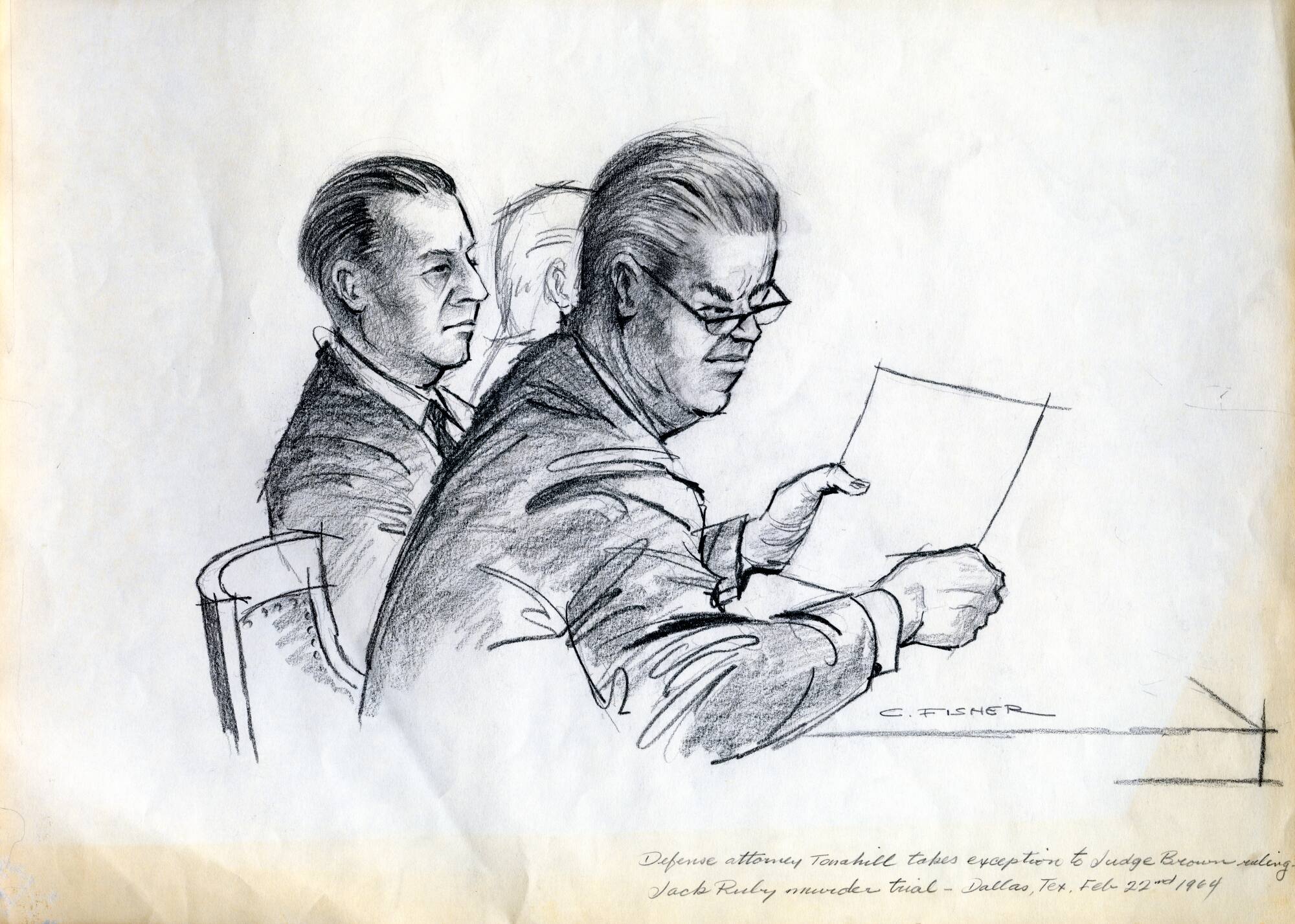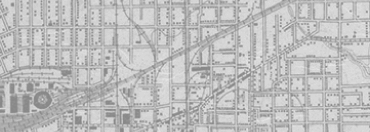


Back
Courtroom sketch of Jack Ruby and defense attorney Joe Tonahill dated 02/22/1964
Courtroom pencil sketch on paper by Charles Fisher. The sketch shows defense attorney Joe Tonahill during the trial of Jack Ruby on February 22, 1964. The sketch shows Tonahill, partially in profile, holding a piece of paper, looking towards the viewer's right presumably at Judge Joe Brown. Jack Ruby can be seen in profile directly behind Tonahill while the outline of another unknown figure is partially visible behind Ruby. The caption in the bottom right reads "Defense attorney Tonahill takes exception to Judge Brown ruling. Jack Ruby murder trial - Dallas, Texas, Feb. 22, 1964"The artist's signature: "C. Fisher" is at bottom right edge, under the right hand of Joe Tonahill. Charles "Chuck" Fisher was the art director at KRLD-TV in 1963. Fisher made the pencil sketches during the trial of Jack Ruby for KRLD-TV after the judge barred cameras from the courtroom.
Courtroom sketch of Jack Ruby and defense attorney Joe Tonahill dated 02/22/1964
02/22/1964
Paper
13 1/2 × 17 in. (34.3 × 43.2 cm)
Charles Fisher Collection/The Sixth Floor Museum at Dealey Plaza
1997.053.0001
Jury selection in the Jack Ruby trial took place between February 17 and March 3, 1964. During that two-week period, 162 prospective jurors were interviewed, which District Attorney Henry Wade informed the news media was not a Dallas County record. Of the 162 individuals interviewed for the Ruby trial, twelve were accepted, eighteen were challenged by the defense team, eleven were challenged by the prosecution, sixty-two were ruled out because they were against the death penalty, fifty-eight were ruled out because they held fixed opinions on the case, and one was excused due to illness. -- Stephen Fagin, Curator
On Saturday, February 22, 1964, a total of five prospective jurors were interviewed for the Jack Ruby trial, including three women. None of those interviewed on February 22 were selected for the trial. By the end of that Saturday court session, only two of twelve jurors had been selected for the Ruby trial. It was probably a nerve-racking experience for any prospective juror with more than 350 reporters and photographers from around the world covering the trial at the Dallas County Criminal Courts building. According to The Dallas Morning News, more than half of the seats in Judge Brown's courtroom, 125 to be exact, were provided to reporters and artists like Charles Fisher of KRLD-TV. The rest were reserved for spectators. Upon taking the stand, all prospective jurors were asked to state their name, marital status, employment background and religious preference before responding to questions about past jury service, whether or not they knew or had heard of Jack Ruby and whether or not they could support the death penalty. -- Stephen Fagin, Curator

Courtroom sketch of Jack Ruby and defense attorney Joe Tonahill dated 02/22/1964
Courtroom pencil sketch on paper by Charles Fisher. The sketch shows defense attorney Joe Tonahill during the trial of Jack Ruby on February 22, 1964. The sketch shows Tonahill, partially in profile, holding a piece of paper, looking towards the viewer's right presumably at Judge Joe Brown. Jack Ruby can be seen in profile directly behind Tonahill while the outline of another unknown figure is partially visible behind Ruby. The caption in the bottom right reads "Defense attorney Tonahill takes exception to Judge Brown ruling. Jack Ruby murder trial - Dallas, Texas, Feb. 22, 1964"The artist's signature: "C. Fisher" is at bottom right edge, under the right hand of Joe Tonahill. Charles "Chuck" Fisher was the art director at KRLD-TV in 1963. Fisher made the pencil sketches during the trial of Jack Ruby for KRLD-TV after the judge barred cameras from the courtroom.
Courtroom sketch of Jack Ruby and defense attorney Joe Tonahill dated 02/22/1964
02/22/1964
Sketches
Artwork
Artist
Trials
Jack Ruby trial
Attorney
Ruby, Jack
Tonahill, Joe H.
Fisher, Charles
KRLD-TV
Dallas
Paper
13 1/2 × 17 in. (34.3 × 43.2 cm)
Charles Fisher Collection/The Sixth Floor Museum at Dealey Plaza
1997.053.0001
Jury selection in the Jack Ruby trial took place between February 17 and March 3, 1964. During that two-week period, 162 prospective jurors were interviewed, which District Attorney Henry Wade informed the news media was not a Dallas County record. Of the 162 individuals interviewed for the Ruby trial, twelve were accepted, eighteen were challenged by the defense team, eleven were challenged by the prosecution, sixty-two were ruled out because they were against the death penalty, fifty-eight were ruled out because they held fixed opinions on the case, and one was excused due to illness. -- Stephen Fagin, Curator
On Saturday, February 22, 1964, a total of five prospective jurors were interviewed for the Jack Ruby trial, including three women. None of those interviewed on February 22 were selected for the trial. By the end of that Saturday court session, only two of twelve jurors had been selected for the Ruby trial. It was probably a nerve-racking experience for any prospective juror with more than 350 reporters and photographers from around the world covering the trial at the Dallas County Criminal Courts building. According to The Dallas Morning News, more than half of the seats in Judge Brown's courtroom, 125 to be exact, were provided to reporters and artists like Charles Fisher of KRLD-TV. The rest were reserved for spectators. Upon taking the stand, all prospective jurors were asked to state their name, marital status, employment background and religious preference before responding to questions about past jury service, whether or not they knew or had heard of Jack Ruby and whether or not they could support the death penalty. -- Stephen Fagin, Curator









